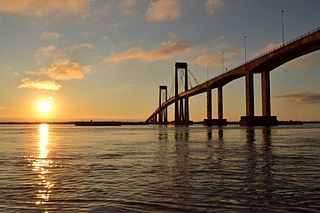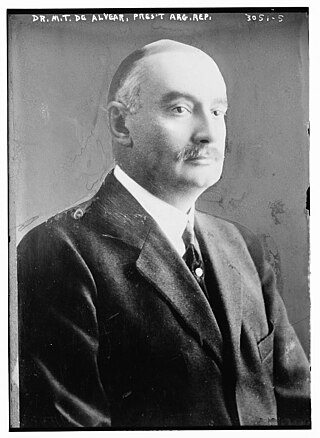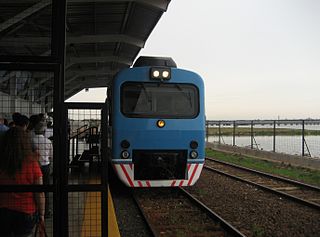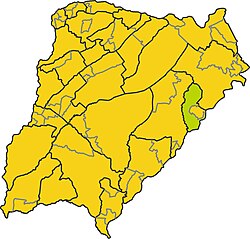
Corrientes, officially the Province of Corrientes is a province in northeast Argentina, in the Mesopotamia region. It is surrounded by : Paraguay, the province of Misiones, Brazil, Uruguay, and the provinces of Entre Rios, Santa Fe and Chaco.

Corrientes is the capital city of the province of Corrientes, Argentina, located on the eastern shore of the Paraná River, about 1,000 km (621 mi) from Buenos Aires and 300 km (186 mi) from Posadas, on National Route 12. It has a population of 346,334 according to the 2010 Census. It lies opposite its twin city, Resistencia, Chaco.

Uruguaiana is a municipality in the Brazilian state of Rio Grande do Sul. It is located on the eastern shore of the Uruguay River bordering Argentina. Opposite to Uruguaiana, and joined to it by a road/railway bridge, lies the Argentine city of Paso de los Libres, Corrientes. North of Uruguaiana lies the Brazilian municipality of Itaqui, connected by a bridge constructed by the British in 1888 over the Ibicuí River. The municipality also borders the municipalities of Alegrete, Barra do Quaraí and Quaraí, and, also, Uruguay, making it one of the few international triple-border municipalities of Brazil.

Máximo Marcelo Torcuato de Alvear Pacheco, was an Argentine lawyer and politician, who served as president of Argentina between from 1922 to 1928.

Carlos María de Alvear, was an Argentine soldier and statesman, Supreme Director of the United Provinces of the Río de la Plata in 1815.
San Martín or San Martin may refer to:

Recoleta is a barrio or neighborhood of Buenos Aires, Argentina, located in the northern part of the city, by the Río de la Plata. The area is perhaps best known to be the home of the distinguished Recoleta Cemetery. It is a traditional upper-class and conservative neighborhood with some of the priciest real estate in the city, known for Paris-style townhouses, lavish former palaces and posh boutiques.

Gualeguaychú is a city in the province of Entre Ríos, Argentina, on the left bank of the Gualeguaychú River. It is located on the south-east of the province, approximately 230 km north-west of Buenos Aires. It has a population of 109,266 according to the 2010 Census.

Bagé is a Brazilian municipality located in the state of Rio Grande do Sul. In 2020, its population was 121,335 in a total area of 4,096 km2. It is the seventeenth largest city in the state according to the 2011 census. The city was founded in 1811 and given city status in 1859. Due to its strategic border location, Bagé has remained of significant military importance. Prior to official reorganization as a city, Bagé was seized by military forces from Uruguay and Argentina.

The following is an alphabetical list of topics related to the Argentina.

In the Paraguayan War, the Battle of Yatay was fought on August 17, 1865, between the troops of the Triple Alliance and the soldiers of Paraguay near Paso de los Libres, Corrientes, Argentina.

{{Short description| A municipality in Brazil}

General Alvear Partido is a partido in Buenos Aires Province in Argentina.

General Alvear is a department located in the south east of Mendoza Province in Argentina.

The General Urquiza Railway (FCGU), named after the Argentine general and politician Justo José de Urquiza, is a standard gauge railway of Argentina which runs approximately northwards from Buenos Aires to Posadas, with several branches in between. It was also one of the six state-owned Argentine railway companies formed after President Juan Perón's nationalisation of the railway network in 1948. The six companies were managed by Ferrocarriles Argentinos which was later broken up during the process of railway privatisation beginning in 1991 during Carlos Menem's presidency.

Ricardo Ramón López Jordán (1822–1889) was an Argentine soldier and politician, one of the last influential "caudillos" in the history of Argentina. He thrice rebelled against the government of Buenos Aires and was defeated in each attempt.
Margarida Cabral de Melo (1570–1631) was a Portuguese noblewoman related to the discoverer of Brazil Pedro Álvares Cabral. In 1599 she settled with her husband and children in Buenos Aires. She was one of the most distinguished women in the Río de la Plata, in the early 17th century, owned of luxury homes, farms and vineyards.

The Corrientes campaign or the Paraguayan invasion of Corrientes was the second campaign of the Paraguayan War. Paraguayan forces occupied the Argentinian city of Corrientes and other towns in Corrientes province. The campaign occurred at the same time as the Siege of Uruguaiana.

The Invasion of Rio Grande do Sul began on June 10, 1865 when about 7,500 soldiers under the command of General Antonio de la Cruz Estigarribia invaded the village of São Borja near Brazil's border with Argentina. About 3,000 men commanded by major Pedro Duarte stayed on the other side of the Uruguay River to accompany the advance of the main column. The Paraguayans always advanced along the river without major damage, with the exception of a confrontation on the Butuí River where a Paraguayan battalion had been defeated, until they reached Uruguaiana, where a two-month siege made them surrender unconditionally on September 18. The main objective of Paraguayan president Francisco Solano López to invade Rio Grande do Sul was to force a peace treaty favorable to the Paraguayans with the Empire of Brazil. The action took place in the second phase of the Paraguayan War, known as the Corrientes campaign.



















